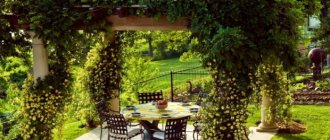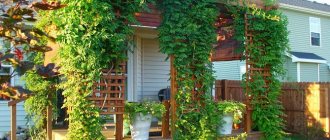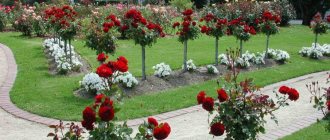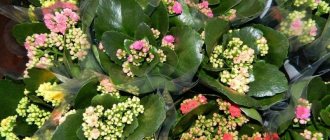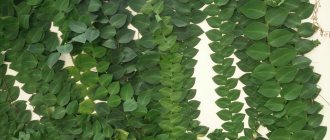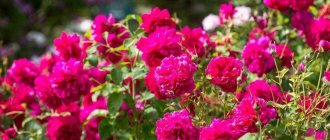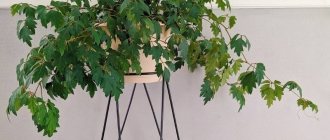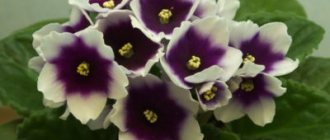Perennial vines with decorative leaves
To choose climbing perennials, you should know that they are divided into several types: creeping (for landscaping horizontal areas), climbing (with suckers on the stems) and clinging to supports.
If you want to create a hedge, then choose perennial climbing plants with decorative carved leaves or leaves of an unusual, bizarre shape.
Typically, these crops are not afraid of frost, drought-resistant, and do not require special care. Most often they are used for landscaping a fence, especially if the fence spoils the appearance of the site, as well as any garden and outbuildings.
Amur grapes
Amur grape is an unpretentious plant; if planted near a fence or unsightly outbuilding, it will quickly fill the space and decorate the object. The length of an adult grape is 20 meters.
From its name we can conclude that the plant is not afraid of frost. Indeed, Amur grapes have the highest frost resistance among grape species.
The plant appeared before the Ice Age, and then successfully took root in harsh conditions, so it is not afraid of any frost.
By planting a vine along the fence, you will soon have a magnificent hedge, and even enjoy delicious fruits. This grape variety can be safely shaped as you wish; it is not afraid of pruning. Even after shearing, it will be strewn with bunches of berries.
Euonymus rotundifolia
One of the most beautiful climbing plants can be called rotundifolia. The liana can be used to decorate high fences, pergolas, gazebos, and trellises. The bush quickly climbs to any height using flexible lashes.
But wood pliers are dangerous to other plants. They can destroy any tree by tightly hugging its trunk and digging their lashes deeply into it. In his strong embrace, other trees simply die. This destroyer should not be allowed to be near a tree of any kind.
Wood pliers are unpretentious and can grow in any place, creating beautiful pictures without requiring any care. You just need to plant it somewhere separately.
Actinidia
If you have a shaded fence or wall of a house where little light penetrates, then plant actinidia. She doesn't like to be in the sun. To create original vertical compositions in the garden, actinidia is also best suited.
It can grow on any soil. And not just to grow, but to annually present the owners with delicious oblong fruits. Breeders have developed many varieties of actinidia that produce good harvests. The most generous harvest varieties are: Soroka, Prazdnichny, Slastena, Lakomka.
The fruits of this plant, similar to kiwi, are endowed with many useful vitamins and microelements.
Maiden grapes
Another type of grape is girlish grape. It will grow well wherever you find a place for it, the main thing is to prune it in a timely manner. It can take a liking to arches, walls, fences, or occupy the entire free surface of the dacha.
With its help, it is easy to landscape the most unsightly area in the garden. It is unpretentious and grows very quickly, which is what attracts gardeners.
Honeysuckle Kamchatka
Kamchatka honeysuckle is more capricious than other plants that are planted as a hedge. She does not like drafts and shaded places. Kamchatka honeysuckle bushes should be planted in sunny areas, regularly watered and fertilized.
It is valuable that this shrub is not afraid of frost and produces tasty fruits rich in vitamins C, B, P and microelements beneficial to humans.
garden ivy
Another beautiful plant that can decorate any structure is garden ivy.
If you need to cover the gazebo with a green carpet, then ivy is the most convenient plant. One of the most unpretentious climbing plants is ivy. It can grow up to 30 meters in height, so it can entwine even the highest supports.
For gazebos and pergolas, this is not only a decoration, but also a way to create a romantic, private place in the garden.
Planting should be carried out with seedlings 2-3 years old. They are planted in spring in shallow holes with organic fertilizer. In summer it must be trimmed to any shape. But before winter frosts, the ivy roots must be covered with earth, leaves, and then with a special coating.
Garden ivy is easy to care for, but prefers fertilized soil, so from time to time it needs to be fertilized, as well as watered and pruned.
Kirkazon largeleaf
Kirkazon largeleaf is capable of creating an amazing picture - neatly laid tiles. This plant can grow in any soil, but is very afraid of drafts. It is worth noting its picturesque appearance and high frost resistance.
Any arch, pergola, gazebo can be decorated with a picturesque steeplejack, and a green tunnel can be created. Flowers of unusual shape and outlandish color are striking, as well as its miraculous medicinal properties, which are widely used in folk medicine.
Actinidia is a distant relative of kiwi
Actinidia can be grown as an ornamental or fruit plant, it all depends on the variety. This is a powerful vine that changes the color of the foliage from white at the beginning of the growing season to pink after flowering.
Actinidia shoots reach 7 meters in length. This is enough to make decorative pergolas, arches, and also selectively decorate the walls of a house, buildings, or gazebos.
Actinidia is unpretentious in care, but will respond positively to regular watering. The plant grows on any type of soil, tolerates partial shade, and is not afraid of frost. therefore, it can be grown in dachas in central Russia and even in Siberia.
The vine is heavy, so increased demands are placed on the strength of the support.
Deciduous perennial vines for hedges
The variety of climbing flowering vines that are used to decorate fences and unsightly areas in the country is amazing. Abundantly flowering plants for a fence can turn it into a picturesque picture.
Climbing plants are good because they grow in one place for several years. In order not to place a support near them, plant flowering vines near the fence, around the gazebos.
Here are fast-growing climbing plants for fences, arbors and arches.
Clematis
Climbing flowers called “clematis” are one of the most beloved plants among gardeners. What did they do to deserve such a position? Clematis grows quickly, blooms beautifully throughout the summer, and is not too capricious.
Before planting climbing clematis on the site, you should choose a variety. The thing is that each variety has flowers that differ in shape and color.
Bizarre flowers can be in the form of an open bowl, a wilted bell, or an unopened jug. The most favorite are the varieties where the plants bloom with purple flowers.
climbing roses
The leader among crops for decorating arches, fences, gazebos, and pergolas are gorgeous climbing roses. The climbing rose has many advantages:
- It is unpretentious;
- A huge number of flowering varieties have been developed;
- It grows very quickly and lives in one place for a long time;
- There are varieties that can bloom 2 times during the summer.
Climbing roses can entwine any support and decorate the area. In order for roses to bloom profusely, they must be periodically watered and fed with complex fertilizers.
Climbing plants immediately attract attention, and anyone who sees a flowering fence or a gazebo entwined with flowers will definitely wish to have such beauty in their dacha.
Kampsis
These perennial climbing flowers are characterized by very fast growth, which has earned them the love of gardeners.
Campsis is the most unpretentious plant, with unusual flowers. The orange flowers look like inverted tubes.
Its only drawback: it needs to be covered for the winter if frosts exceed minus 18 degrees.
Cover it with spruce branches, dry leaves, and then with covering material or burlap. There is no need to cover them with plastic wrap; they will die under it.
Wisteria
Wisteria is an unusually luxurious plant that can decorate gazebos and all small architectural garden forms. It is memorable for its lush clusters of lilac flowers, which bloom so luxuriantly that they cover all the greenery. The inflorescences reach a length of 50 cm in length, which amazes at first sight.
The plant loves warmth, so it requires shelter for the winter so that the shoots do not freeze. If the shoots freeze, then in the spring the vine may produce new branches. But it will not bloom, because buds form only on last year’s shoots.
Highlander - a fragrant liana for the cottage and garden
There are several types of knotweed, including a perennial vine. This plant has fast-growing shoots and long flowering. In central Russia, Baljuan knotweed is planted, which has good winter hardiness.
Baljuan knotweed is distinguished by its extremely fast vine growth. During the season it can grow up to 6 meters. The plant tolerates frosts down to -20 °C. At lower temperatures, the above-ground part of the vine dies, but the roots and part of the plant under the snow remain alive. They will resume rapid growth in the spring.
The climbing knotweed does not have tendrils, suckers or aerial roots, so a trellis is needed to grow it. Without a trellis, the plant weaves horizontally; this quality is used to strengthen crumbling slopes.
Knotweed should not be planted next to trees - it will inhibit their growth and break branches.
Blooming perennial vines
Schisandra chinensis
Chinese lemongrass can surprise you with its beauty and taste of its berries. This climbing plant retains its decorative value even in autumn, thanks to the blazing red fruits.
When planting this plant in the garden, you need to take care of support. The vine will wrap around the support and climb up. When lemongrass blooms with white flowers, a pleasant aroma will hover around the vine. It is noteworthy that the flowers will gradually acquire a pink tint during flowering.
What care does this plant require? To get bunches of beautiful berries in the fall, you need to water it, trim off excess branches and mulch the soil around the roots.
Schisandra can grow up to 10 -15 meters, but in the regions of Russia it grows no more than 4 meters. You can plant several seedlings, providing them with support. You will get a beautiful flowering fence, which by autumn will be covered with red berries.
Hydrangea climbing
The flowering vine can be used as a fence and for landscaping facades and fences. But many gardeners plant hydrangea to decorate a free plot of land in their country house.
Climbing hydrangea can become a ground cover plant and cover a flowering carpet, for example, the tree trunk under an apple tree.
Most often, climbing hydrangea is planted against a solid wall, where it climbs to the very top, blooming snow-white flowers. The plant is quite unpretentious. In dry summers it requires watering and fertilizing in the fall.
Wild grapes
Wild grapes can decorate the facade of a house. Clinging to rough walls with its antennae, it can climb all the way to the roof.
Grows on any soil. By planting several cuttings around the house, in a couple of years you will get a lush wall decoration. In the third year, the grapes will bloom and bear fruit, but require timely pruning.
Advantages of wild grapes:
- Grows quickly, aesthetically pleasing;
- Winter-hardy, does not require shelter for the winter;
- Not afraid of pests, does not require much feeding;
- The bushes of the plant are capable of pumping out excess moisture from the ground. By planting virgin grapes near the house, you can drain the cellar of water;
- By decorating a street fence, you will get a chic hedge and protection from prying eyes;
- Suitable for landscaping gazebos. Dense growth creates coolness and shade;
- In autumn, the vine foliage takes on a pleasant purple hue.
Wild grapes also have disadvantages. The most important of them is that in winter the wall of a house covered with dry branches will not look at all aesthetically pleasing. You should not plant it very close to the wall of the house, as it produces strong roots that can penetrate under the wall.
How to make a trellis for climbing plants
Climbing Plant Support
A trellis is typically used to support climbing plants, but it can also decorate a wall or create a private nook. Make your own trellis using 1.8 - or 2.4 meter slats of 2.5 - 5 cm cedar and 3 cm bolts.
- Make a plan.
- Draw parallel lines with chalk on a flat surface at a distance of 15 cm from each other, then draw perpendicular lines intersecting them at the same distance. Lay out all the ingredients.
- Assemble the model.
- Connect the components.
- Screw the bolts into the intersection points of the grille slats.
- Paint and hang.
The paint will protect the wood from moisture. Hang the structure with the heads of the bolts to the wall so that they are not visible.
All you have to do is choose a suitable climbing plant and decorate your garden. If you wish, you can plant several plants - as many as you can manage to sufficiently care for them.
Annual loaches
Not all gardeners prefer perennial plantings of climbing plants. Many people want to have a different picturesque picture on their site every year.
Climbing annuals have the following advantages:
- Easily propagated by seeds, grows quickly;
- Savings on purchasing seedlings;
- You can create many options when creating a landscape design by choosing different varieties of vines.
You won’t get bored with climbing annuals, because every year you can plant different varieties that will delight you with flowers of all shades and shapes.
morning glory
Morning glory is very similar to the well-known bindweed, but unlike ordinary bindweed, it can grow up to 5 meters. The leaves of the plant can be heart-shaped or openwork. Flowers can also come in a variety of colors.
Morning glory flowers, opening with the sunrise, turn after it. For this ability, morning glory has another name - “flower of dawn”. In dry summers it requires watering.
Shade-loving loaches
Not all summer residents have areas completely flooded with sun. There are places in the shade that you also want to decorate with beautiful flowers.
Aristolochia (kirkazon)
A plant with large leaves and original flowers looks very beautiful when it entwines coniferous trees. Against the background of dark spruce trees, Aristolochia stands out unusually beautifully.
If the hedge is made of coniferous trees, then in some places a solid coniferous wall can be diluted with aristolochia.
Prince
Prince is a close relative of clematis, but is not at all demanding of care. The flower is interesting because it blooms very early. Its large white, blue or purple flowers will decorate any support.
It quickly entwines the wall with jagged edges of leaves and rises up, creating a very beautiful picture.
Evergreen climbing plants
To decorate the landscape of their garden, gardeners plant evergreen climbing plants. This is beautiful and practical, because the plant remains green even in cold weather.
Snow-white evergreen honeysuckle
Snow-white evergreen honeysuckle can grow up to 6 meters in height. Due to its high growth, it is very suitable for creating a high vertical hedge. You can’t pass by the picturesque fence without admiration.
She loves to be looked after, regularly watered with warm water and fertilized. Honeysuckle will respond with beautiful flowering.
Passionflower
The evergreen liana surprises with large exotic flowers with a delicate aroma. Depending on the species, star-shaped flowers can be white, blue, purple or red.
Passionflower blooms only for a day, releasing an endless number of buds. Some plant species produce edible fruits—passion fruit.
Climbing plants for the garden
Passionflower
Passion flower is a beautiful climbing plant for the garden, with intricate patterns of stems and beautiful flowers.
It is a perennial in warm climates and an annual plant in colder zones; it grows quickly and produces magnificent flowers. Does not like soil that is too wet, so plant it in a sunny location.
Read also how to grow Chinese lemongrass!
Hyacinth beans
The thin, curved bean pods are tropical hyacinth beans. Flowers bloom against a backdrop of purple-hued foliage as the air begins to feel cool. Purple bindweed (“Morning Glory”). To create a private flowering spot, grow purple bindweed (morning glory) on a trellis. Or “throw” climbing morning glory over a net.
This fast-growing annual climber produces a profusion of tube-shaped flowers that open in the morning and usually close in the afternoon. Morning Glory is self-propagating, so don't be surprised if you see this plant in your garden next year. Plants grow up to 3.5 meters in height.
Climbing plant "Black-eyed Susan"
Add a splash of color to your summer garden by planting fast-growing Black-eyed Susan (Thunbergia alata). Most varieties bloom yellow and orange. 'Little Susie' produces unusual white flowers with chocolate purple centers. This docile plant climbs along a trellis, mesh or pole. It can be either annual or perennial, depending on the climate.
Clematis
Clematis
Few climbers offer such a wide range of colors as clematis - white, pink, blue, purple, yellow, burgundy, and even striped flowers adorn this plant. The shape of the flowers of this perennial plant is also very diverse: double, single, with frills in the middle; Sizes and flowering times also vary.
Recommendations!
Gardener
Ask a Question
In small yards, plant dwarf varieties in containers or along the porch. Most clematis grow best in full sun in moist, well-drained soil.
Campsis rooting
Campsis
This fast-growing perennial vine of the begonia family can reach a height of up to 12 meters. Butterflies love orange, red or yellow flowers, which form showy clusters that stand out against the small, dark green leaves. Loves sun or shade, but the most beautiful flowers are in sunny places. This woody plant becomes very heavy, so it must be planted near a sturdy structure.
Climbing plant Maiden grape
Maiden grapes
Maiden grapes are famous not for their flowers, but for their spectacular, rich red foliage, which becomes so in the fall. Its purple fruits attract birds but are poisonous, so plant this plant in an area that is difficult to reach by people and pets.
Wild grapes
In autumn, wild grapes become noticeable with dark green foliage that gradually turns red. This plant, native to North America, is very vigorous - it rises to a height of up to 15 meters.
Ivy
This variegated foliage plant grows well in hanging baskets, can grow as a trailing plant, or can be trimmed to a shape. He needs partial shade. The soil should be evenly moist and the humidity high to discourage spider mites. This plant also grows as a trailing plant outdoors.
Fast growing climbing plants
Every gardener wants to quickly decorate a garden plot or transform a fence, rather than wait years for a dense hedge to appear. To do this, you need to choose those plants that grow quickly.
Bougainvillea
This perennial loach came to us from Brazil. Breeders have received a large number of varieties to suit every taste.
Bougainvillea grows well in full sun and prefers regular watering. But he doesn’t like the cold; even at minus 5 degrees he can die.
In order for the vine to survive, it is removed in a warm room in the fall.
This plant should not be chosen to decorate a fence. To create a semblance of a hedge, you can place tubs with this plant near the fence. In tubs it is easier to put it away in a warm room for the winter.
Spiraea meadowsweet
Spiraea meadowsweet is a fast-growing shrub that will decorate any corner of the garden. It grows quickly and blooms very beautifully. But he loves good care. In dry summers it is necessary to water and feed frequently.
Features of climbing plants
There are 2 types of decorative vines:
Annuals. They grow quickly and reproduce by seeds. Their stems are herbaceous. There are light-loving and shade-tolerant varieties.
Perennials. With tree-like stems - each new season they continue their growing season. With herbaceous stems, they die off every autumn, and the next year new ones grow from the rhizomes.
IMPORTANT: The stems of some perennials do not tolerate frost, so they must be covered for the winter, removed from their supports and wrapped in insulation.
Differences in growth method:
- Creeping. They need support and a mandatory garter. Otherwise, they will be lined with a continuous carpet on the ground. Clinging. They are attached to the frame independently, with the help of shoots and antennae.
- Climbing. They can do without supports and confidently cling to surfaces with their suction cup roots. Only the walls should be rough.
IMPORTANT: Before planting them, you need to think through and prepare the supports in advance. For some, stretched thin cords are sufficient, while others require strong wood or metal structures.
Selection and features of landing
To plant climbing plants, you need to know their flowering range. A hedge will look beautiful if some vines fade and others come to replace them. With this planting, from early spring to late autumn, you will have a bright environment of flowers.
Planting close to the walls of houses and other buildings is not recommended. It is necessary to retreat 30 cm from the place of support so that the roots of the seedlings have a sufficient amount of soil for strengthening.
Before planting, you need to add into the hole the fertilizer that this particular plant needs. Do not plant plants too densely, as this will prevent you from creating a beautiful hedge. The plants will be cramped.
The gap between seedlings should be 1.5-2 meters so that each vine receives enough light, air, nutrition and moisture.
